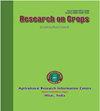南瓜粉和菠萝蜜粉掺入对小麦面包功能特性的影响
Q3 Agricultural and Biological Sciences
引用次数: 0
摘要
南瓜富含类胡萝卜素,类胡萝卜素是一种有价值的维生素a原,以维持视力而闻名。同时,菠萝蜜种子也富含碳水化合物,但它被认为是废物,通常在菠萝蜜加工过程中被丢弃。本研究的目的是利用有价值的南瓜粉和廉价的菠萝蜜籽粉中的碳水化合物,部分替代小麦粉制成面包。研究了100%小麦粉、90:5:5(小麦:南瓜:菠萝蜜粉)、80:10:10(小麦:南瓜:菠萝蜜粉)、70:15:15(小麦:南瓜:菠萝蜜粉)和60:20:20(小麦:南瓜:菠萝蜜粉)的混合配方对面包吸湿性、容重、膨松率、面包高潮、面包尺寸和硬度等功能性能的影响。结果表明,增加小麦粉中南瓜粉和菠萝蜜粉的掺入量,可以提高面包的硬度,但会降低面包的吸湿能力、容重、膨松率、面包高潮和面包尺寸。使用100%小麦粉制作的对照面包在功能特性方面没有显著差异。根据研究结果,建议在90%的小麦面粉中添加5%的南瓜粉和5%的菠萝蜜籽粉可以成功地制作面包,同时保持接近100%小麦面包的功能特性。这项研究的结果促进了将南瓜和菠萝蜜籽等未充分利用的有价值的面粉原料纳入面包制作中。本文章由计算机程序翻译,如有差异,请以英文原文为准。
Functional properties of wheat-based bread affected by pumpkin flour and jackfruit seed flour incorporation
Pumpkin is a rich source of beta-carotenoid, a valuable pro-vitamin A known for maintenance of eye vision. Meanwhile jackfruit seed is also rich in carbohydrate however it is considered as waste product and normally discarded during jackfruit processing. The purpose of this research work was to utilize the valuable pumpkin flour as well as the cheap carbohydrate source from jackfruit seed flour in partial replacement with wheat flour to develop bread. The different blending formulations with 100% wheat flour, 90:5:5 (wheat :pumpkin :jackfruit seed flour), 80:10:10 (wheat :pumpkin :jackfruit seed flour), 70:15:15 (wheat :pumpkin :jackfruit seed flour) and 60:20:20 (wheat :pumpkin :jackfruit seed flour) were tested and their effect on the functional properties (moisture uptake ability, bulk density, bloating ratio, loaf climax, loaf dimension and hardness) of bread was investigated. Results showed that increasing the pumpkin flour and jackfruit seed flour incorporation in wheat flour increased the hardness but reduced the moisture uptake ability, bulk density, bloating ratio, loaf climax, and loaf dimension of bread. There was no significant difference between the control bread prepared using 100 % wheat flour in respect of functional properties. Based on the findings of the study, it is recommended that 5% pumpkin flour and 5% jackfruit seed flour could be successfully supplemented in 90% wheat flour for bread making, while maintaining the the functional properties close to 100% wheat-based bread. Findings of this research facilitated the incorporation of the underutilized and valuable flour-based sources like pumpkin and jackfruit seed in bread making.
求助全文
通过发布文献求助,成功后即可免费获取论文全文。
去求助
来源期刊

Research on Crops
Agricultural and Biological Sciences-Soil Science
CiteScore
1.50
自引率
0.00%
发文量
93
审稿时长
1 months
期刊介绍:
The Research on Crops is a peer-reviewed journal publishing original research papers, review articles and short communications in English on all basic and applied aspects of crop sciences, agricultural water management, agro-climatology, agroforestry, agronomy, crop production, crop protection, cropping systems, food science & technology, genetics & plant breeding, horticulture, plant & soil science, plant biotechnology, plant nutrition, post-harvest management of crops, seed science, soil management & tillage, vegetables, weed science, agricultural engineering, agri-business, agricultural economics and extension, etc. The aim of the journal is to provide a forum for the scientific community to publish their latest research findings.
The manuscripts submitted for publication should not contain data older than 4 years on the date of submission.
The articles submitted for publication in this journal should not be submitted elsewhere simultaneously for publication in another journal. These should not carry any copyright material without prior permission of copyright holder.
The articles should present a complete picture of the investigation made and should not be split into parts.
There is no prescribed limit regarding the number of pages in case of full-length articles. However, the authors are advised to keep the length of their articles from 4 to 10 full printed pages of the journal.
The articles should be divided into the sub-sections: ABSTRACT, INTRODUCTION, MATERIALS AND METHODS, RESULTS AND DISCUSSION, CONCLUSIONS, and REFERENCES. Tables and figures should be appended separately at the end.
 求助内容:
求助内容: 应助结果提醒方式:
应助结果提醒方式:


